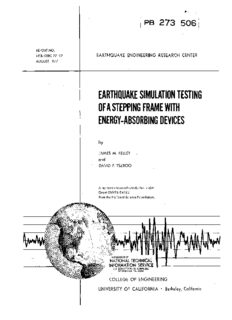
earthquake simulation testing ofastepping frame with energy-absorbing devices PDF
Preview earthquake simulation testing ofastepping frame with energy-absorbing devices
rPB 273 506 REPORTNO. UCBIEERC-77117 EARTHQUAKE ENGINEERING RESEARCH CENTER AUGUST 1977 EARTHQUAKE SIMULATION TESTING OFASTEPPING FRAME WITH ENERGY-ABSORBING DEVICES by JAMES M. KElLEY and DAVID F. TSZTOO A reporton research conducted under GrantENV76-04262 from theNational Science Foundation. REPRODUCEDBY NATIONAL TECHNICAL INFORMATION SERVICE +-----"---------- u.S.DEPARTMENTOFCOMMERCE SPRINGFIELD,VA.22161 COLLEGE OF ENGINEERING UNIVERSITY OF CALIFORNIA . Berkeley, California .. - , BIBLIOGRAPHIC DATA 11, Report No. UCB/EERC-n /17 3. Recipient's Accession No. SHEET 4. Title and Subtitle 5. Report Date August 1977 Earthquake Simulation Testing of a Stepping Frame with Energy-Absorbing Devices 6. 7. Author(s) 8. Performing Organization Rept. James M. Kelley and David F. Tsztoo No. 77/17 9. Performing Organization Name and Address 10. Project/Task/Work Unit No. Earthq~ake Engineering Research Center University of California, Berkeley 11. Contract/Grant No. 47th Street and Hoffman Blvd. ENV76-04262 Richmond, California 94804 12. Sponsoring Organization Name and Address 13. Type of Report & Period National Science Foundation Covered 1800 GStreet, N.W. Washington, D.C. 20550 14. 15. Supplementary Notes 16. AbstrRacetssults are reported of earthquake simulation tests on a model frame with a partial base isolation system that includes energy-absorbing devices. The isolation system was modeled on a stepping bridge concept developed for New Zealand Railways, and the energy-absorbing devices, based on the plastic torsion of rectangular mild steel bars, functioned only when the frame base lifted off the foundation. Two series of tests using scaled accelerations from the El Centro N-S 1940 and Pacoima Dam 1971 earth quake ground motion records were used as input to the shaking table on which the tests ( were performed. Results from these tests are compared to those from earlier tests on an identical frame with the foundation (1) anchored as in conventional design, and (2) permitted to uplift freely. The response of the frame with the energy-absorbing devices installed was imnroved over that of both the fixed frame and the frame allowed to uplift freely for the' El Centro accelerations. Although the results are not as favorable for the Pacoima Dam input, the feasibility of the energy-absorbing devices associated with a partial base isolation system is established as. an alternaj:ive to anchored frames and frames allowed to uplift freely. 17b. Identifiers/Open-Ended Terms . , 17c. COSATI Field/Group 18. Availability Statement 19•.Security Class (This 21. Re~?rt) Release Unlimited IINrl A 20. Security Class (This Page UNCLASSIFIED FORMNTI5-35 (REV. 10-73) ENDORSED BY ANSI ANDUNESCO, THIS FORMMAYBE REPRODUCED USCOMM-DC 82G5-P74 EARTHQUAKE SIMULATION TESTING OF A STEPPING FRAME WITH ENERGY-ABSORBING DEVICES by J. M. Kelly and D. F. Tsztoo Report to: National Science Foundation, Grant ENV76-04262 Report No. UCB/EERC-77/17 Earthquake Engineering Research Center College of Engineering University of California Berkeley, California August 1977 . , ~/ ib ABSTRACT Results are reported of earthquake simulation tests on a model frame with a partial base isolation system that includes energy-absorbing devices. The isolation system was modeled on a stepping bridge concept developed for the New Zealand Railways, and the energy-absorbing devices, based on the plastic torsion of rectangular mild steel bars, functioned only when the frame base lifted off the foundation. Two series of tests using scaled accelerations from the El Centro N-S 1940 and Pacoima Dam 1971 earthquake ground motion records were used as input to the shaking table on which the tests were performed. Results from these tests are compared to those from earlier tests on an identical frame with the foundation (1) anchored as in conventional design, and (2) permitted to uplift freely. The response of the frame with the energy-absorbing devices installed was improved over that of both the fixed frame and the frame allowed to uplift freely for the El Centro accelerations. Although the results are not as favorable for the Pacoima Dam input, the feasibility of the energy-absorbing devices associated with a partial base isolation system is established as an alternative to anchored frames and frames allowed to uplift freely. ii ACKNOWLEDGMENTS The research reported herein was supported by National Science Foundation Grant ENV76-04262.
Description: